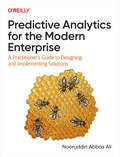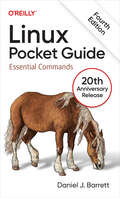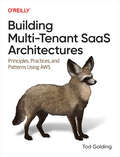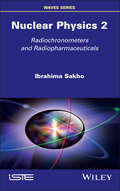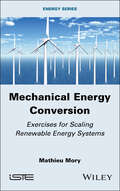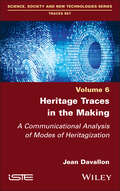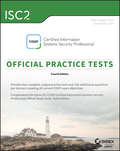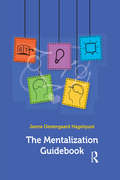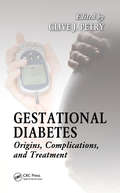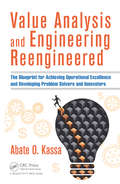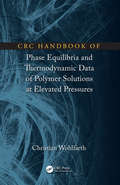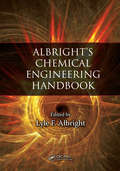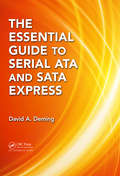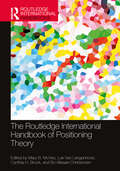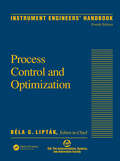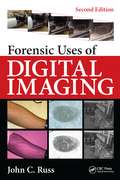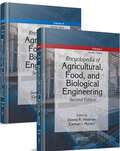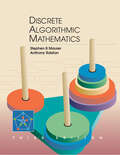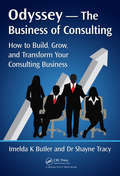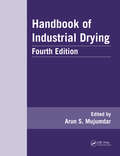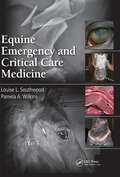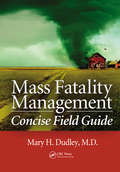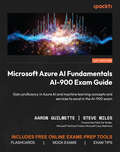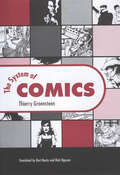- Table View
- List View
Predictive Analytics for the Modern Enterprise: A Practitioner's Guide To Designing And Implementing Solutions
by Nooruddin Abbas AliThe surging predictive analytics market is expected to grow from $10.5 billion today to $28 billion by 2026. With the rise in automation across industries, the increase in data-driven decision-making, and the proliferation of IoT devices, predictive analytics has become an operational necessity in today's forward-thinking companies.If you're a data professional, you need to be aligned with your company's business activities more than ever before. This practical book provides the background, tools, and best practices necessary to help you design, implement, and operationalize predictive analytics on-premises or in the cloud. Explore ways that predictive analytics can provide direct input back to your businessUnderstand mathematical tools commonly used in predictive analyticsLearn the development frameworks used in predictive analytics applicationsAppreciate the role of predictive analytics in the machine learning processExamine industry implementations of predictive analyticsBuild, train, and retrain predictive models using Python and TensorFlow
Linux Pocket Guide: Essential Commands
by Daniel J. BarrettIf you use Linux in your day-to-day work, then Linux Pocket Guide is the perfect on-the-job reference. This thoroughly updated 20th anniversary edition explains more than 200 Linux commands, including new commands for file handling, package management, version control, file format conversions, and more.In this concise guide, author Daniel Barrett provides the most useful Linux commands grouped by functionality. Whether you're a novice or an experienced user, this practical book is an ideal reference for the most important Linux commands.You'll learn:Essential concepts—commands, shells, users, and the filesystemFile commands-creating, organizing, manipulating, and processing files of all kindsSysadmin basics-superusers, processes, user management, and software installationFilesystem maintenance-disks, RAID, logical volumes, backups, and moreNetworking commands-working with hosts, network connections, email, and the webGetting stuff done-everything from math to version control to graphics and audio
Building Multi-Tenant SaaS Architectures: Principles, Practices, And Patterns Using Aws
by Tod GoldingSoftware as a service (SaaS) is on the path to becoming the de facto model for building, delivering, and operating software solutions. Adopting a multi-tenant SaaS model requires builders to take on a broad range of new architecture, implementation, and operational challenges. How data is partitioned, how resources are isolated, how tenants are authenticated, how microservices are built—these are just a few of the many areas that need to be on your radar when you're designing and creating SaaS offerings.In this book, Tod Golding, a global SaaS technical lead at AWS, provides an end-to-end view of the SaaS architectural landscape, outlining the practical techniques, strategies, and patterns that every architect must navigate as part of building a SaaS environment.Describe, classify, and characterize core SaaS patterns and strategiesIdentify the key building blocks, trade-offs, and considerations that will shape the design and implementation of your multi-tenant solutionExamine essential multi-tenant architecture strategies, including tenant isolation, noisy neighbor, data partitioning, onboarding, identity, and multi-tenant DevOpsExplore how multi-tenancy influences the design and implementation of microservicesLearn how multi-tenancy shapes the operational footprint of your SaaS environment
Nuclear Physics 2: Radiochronometers and Radiopharmaceuticals
by Ibrahima SakhoNuclear Physics 2 explores the applications of various radioisotopes for dating and nuclear medicine imaging. It introduces the theoretical and experimental facts from the observation of the red shift in the spectrum of galaxies (1913), and the discovery of the cosmic microwave background (1965) that led to the validation of the Big Bang model, through which all known chemical elements are created via nucleosynthesis processes. This introduction is followed by a description of the nuclear reactions involved in primordial, stellar, and explosive. The principles of carbon-14, potassium-argon, uranium-thorium and uranium-protactinium dating, along with the principles of lead-210, caesium-137 and beryllium-7 radiochronometers applied to dating, are also described. An overview of the birth of nuclear medicine is given, from the first use of radioisotopes as tracers in plant biology in 1913, to the development of Positron Emission Tomography (PET) in 1975. The method of synthesis of radiopharmaceuticals, quality control of radiopharmaceuticals and the experimental methods of the determination of radiochemical purity are presented. The description of the principles of PET and Single-Photon Emission Tomography (SPECT), the presentation of the different radioisotopes used in TEMPS and PET, as well as the presentation of the main scintigraphies and their uses in nuclear medicine conclude the topics studied.
Mechanical Energy Conversion: Exercises for Scaling Renewable Energy Systems
by Mathieu MoryThis book studies the principles of mechanical energy conversion used in renewable energy sources derived from air and water: wind power, tidal power, hydroelectric power, osmotic energy, ocean thermal energy and wave energy. Mechanical Energy Conversion presents twelve application exercises and their answers. They enable the reader to first understand the physical principles of mechanical energy converters and then learn the method for sizing them. The book also reinforces the concepts of fluid mechanics and hydraulic turbo machinery, which are required to solve the exercises. This book aims to instruct readers on how to design an energy system. For each renewable energy source covered – and based on the quantity of energy or power supplied – it describes the production process, explains how it works and calculates the characteristics and dimensions of its components.
Heritage Traces in the Making: A Communicational Analysis of Modes of Heritagization
by Jean DavallonThe world is full of traces of the past, ranging from things as different as monuments and factories to farms, eco-museums, landscapes, mountaineering and even woven-grass bridges. These traces must be protected and passed on to future generations. Communicational analysis shows that these traces have acquired the status of heritage by becoming communicative beings imbued with a new social life. Up until the 1970s and 1980s, granting this status was the prerogative of the state. New modes then emerged, increasingly involving social actors and the publicization of knowledge. Today, the heritage recognition of these traces also depends on interpretative schemes that circulate in society, notably through the media. Heritage Traces in the Making is aimed at anyone – researchers, professionals and students – who is interested in how heritage is created and how it evolves.
ISC2 CISSP Certified Information Systems Security Professional Official Practice Tests (Sybex Study Guide Ser.)
by David Seidl Mike ChappleFull-length practice tests covering all CISSP domains for the ultimate CISSP prep The ISC2 CISSP Official Practice Tests is a major resource for ISC2 Certified Information Systems Security Professional (CISSP) candidates, providing 1300 unique practice questions. The first part of the book provides 100 questions per domain. You also have access to four unique 125-question practice exams to help you master the material. As the only official practice tests endorsed by ISC2, this book gives you the advantage of full and complete preparation. These practice tests align with the 2024 version of the CISSP Detailed Content Outline to ensure up-to-date preparation, and are designed to cover what you will see on exam day. Coverage includes: Security and Risk Management, Asset Security, Security Architecture and Engineering, Communication and Network Security, Identity and Access Management (IAM), Security Assessment and Testing, Security Operations, and Software Development Security. The CISSP credential signifies a body of knowledge and a set of guaranteed skills that put you in demand in the marketplace. This book is your ticket to achieving this prestigious certification, by helping you test what you know against what you need to know. Test your knowledge of the 2024 CISSP domains Identify areas in need of further study Gauge your progress throughout your study and preparation Practice test taking with Sybex’s online test environment containing the questions from the book The CISSP objectives are refreshed every few years to ensure that candidates are up-to-date on the latest security topics and trends. Currently-aligned preparation resources are critical, and periodic practice tests are one of the best ways to truly measure your level of understanding.
The Mentalization Guidebook
by Janne Oestergaard HagelquistThis book provides inspiration for using mentalization when working with vulnerable children, adolescents, and their families. It includes the basic models of mentalization and provides ways to support the neglected and traumatised to find a better understanding of themselves and their struggles.
Gestational Diabetes: Origins, Complications, and Treatment
by Clive J. PetryGiven the rapid increase in the worldwide incidence of gestational diabetes, the need for defining the risks and effects associated with raised glucose concentrations in pregnancy is great. Recent large studies are helping to define the risks, as well as identify the benefits of reducing glucose intolerance. Written by an esteemed list of internati
Value Analysis and Engineering Reengineered: The Blueprint for Achieving Operational Excellence and Developing Problem Solvers and Innovators
by Abate O. KassaBy mastering the re-engineered value analysis & value engineering (VA/VE) problem-solving value methodology outlined in this book, any organization will be able to self-diagnose problems and self-discover solutions. The book is the product of Abate Kassa's dual lenses of experience and research over four decades. The book updates and upgrades VA/VE by integrating popular improvement methodologies, including Six Sigma, Lean Manufacturing, Total Quality Management, Kaizen, Business Process Reengineering, and Project Management, into the scientific method of the value methodology he dubbed PISERIA.
CRC Handbook of Phase Equilibria and Thermodynamic Data of Polymer Solutions at Elevated Pressures
by Christian WohlfarthThere is a continuing interest in thermodynamic properties of polymer solutions at elevated pressures. This updated book provides newly published experimental data from the last decade. It includes nearly 500 newly published references containing approximately 175 new vapor-liquid equilibrium data sets, 25 new liquid-liquid equilibrium data sets, 540 new high-pressure fluid phase equilibrium data sets, 60 new data sets describing PVT properties of polymers, and 20 new data sets with densities or excess volumes.
Albright's Chemical Engineering Handbook
by Lyle F. AlbrightTaking greater advantage of powerful computing capabilities over the last several years, the development of fundamental information and new models has led to major advances in nearly every aspect of chemical engineering. Albright's Chemical Engineering Handbook represents a reliable source of updated methods, applications, and fundamental co
The Essential Guide to Serial ATA and SATA Express
by David A. DemingUsed in laptop and desktop computers, low-end servers, and mobile devices, Serial ATA (Advance Technology Attachment), or SATA, is the pervasive disk storage technology in use today. SATA has also penetrated the enterprise computing environment by adding hardware components for fail-over, extending command processing capabilities, and increasing de
The Routledge International Handbook of Positioning Theory (Routledge International Handbooks)
by Luk Van Langenhove Cynthia H. Brock Mary B. McVee Bo Allesøe ChristensenThis handbook is the first of its kind to explore Positioning Theory. Taking inspiration from the groundwork set by Rom Harré and collaborators such as Bronwyn Davies, Fathali Moghaddam, Luk Van Langenhove, and others the book explores the emergence, historical context, and disciplinary applications of Positioning Theory and its basic precepts as a social psychological theory.This volume encompasses over 20 chapters across four sections, assimilating cross-disciplinary insights that try to understand the theoretical underpinnings, methodological applications, and contemporary relevance of Positioning Theory. Part 1 explores the movement of scholarly figures and their numerous works on the subject. It discusses the foundational origins and the historical contexts of the existing theories on positioning and new directions for scholarship. Part 2 examines the methodological and narrative investigations used for data analysis in positioning research, navigating through the epistemological orientations and theoretical landscapes of Positioning Theory. Part 3 explores numerous applications across disciplines to consider the reach and influence of positioning within and across multiple disciplines. Lastly, the authors contemplate the future directions for Positioning Theory.Featuring researchers from leading research institutions from across the globe, the book is important reading for scholars interested in positioning and Positioning Theory. We recommend this handbook for graduate-level courses in social psychology, communication, discourse studies and related disciplines.
Instrument Engineers' Handbook, Volume Two: Process Control and Optimization
by Béla G. LiptákThe latest update to Bela Liptak's acclaimed "bible" of instrument engineering is now available. Retaining the format that made the previous editions bestsellers in their own right, the fourth edition of Process Control and Optimization continues the tradition of providing quick and easy access to highly practical information. The authors are practicing engineers, not theoretical people from academia, and their from-the-trenches advice has been repeatedly tested in real-life applications. Expanded coverage includes descriptions of overseas manufacturer's products and concepts, model-based optimization in control theory, new major inventions and innovations in control valves, and a full chapter devoted to safety. With more than 2000 graphs, figures, and tables, this all-inclusive encyclopedic volume replaces an entire library with one authoritative reference. The fourth edition brings the content of the previous editions completely up to date, incorporates the developments of the last decade, and broadens the horizons of the work from an American to a global perspective. Béla G. Lipták speaks on Post-Oil Energy Technology on the AT&T Tech Channel.
Forensic Uses of Digital Imaging
by John C. Russ Jens Rindel P. LordThe ability to work with, and retrieve images, is vital to forensic and criminal case work. During a five-decade-long career, author John C. Russ has taught methods for image processing and measurement to thousands of students. Forensic Uses of Digital Imaging, Second Edition distills his classroom and workshop material to present the information m
Encyclopedia of Agricultural, Food, and Biological Engineering
by Dennis R. Heldman Carmen I. MoraruThe Definitive Reference for Food Scientists & EngineersThe Second Edition of the Encyclopedia of Agricultural, Food, and Biological Engineering focuses on the processes used to produce raw agricultural materials and convert the raw materials into consumer products for distribution. It provides an improved understanding of the processes used in
Discrete Algorithmic Mathematics
by Anthony Ralston Stephen B. MaurerThoroughly revised for a one-semester course, this well-known and highly regarded book is an outstanding text for undergraduate discrete mathematics. It has been updated with new or extended discussions of order notation, generating functions, chaos, aspects of statistics, and computational biology. Written in a lively, clear style, the book is unique in its emphasis on algorithmics and the inductive and recursive paradigms as central mathematical themes. It includes a broad variety of applications, not just to mathematics and computer science, but to natural and social science as well.
Odyssey --The Business of Consulting: How to Build, Grow, and Transform Your Consulting Business
by Imelda K. Butler Shayne TracyThis book provides consultants with a career framework to build, grow, and transform their consulting businesses by becoming brilliant at the basics. The Odyssey process challenges current thinking and offers a methodology to help readers rise to the top of the profession by applying leading-edge techniques and methodologies.An ideal companion to t
Handbook of Industrial Drying (ISSN)
by Arun S. MujumdarBy far the most commonly encountered and energy-intensive unit operation in almost all industrial sectors, industrial drying continues to attract the interest of scientists, researchers, and engineers. The Handbook of Industrial Drying, Fourth Edition not only delivers a comprehensive treatment of the current state of the art, but also serves as a
Equine Emergency and Critical Care Medicine
by Louise L. Southwood Pamela A. WilkinsEarly recognition of problems by owners, appropriate first aid, and timely referral by field veterinarians improve the chance of survival for horses requiring emergency management and critical care. With a view toward improving patient outcome, Equine Emergency and Critical Care Medicine is written by a team of enthusiastic equine specialists who e
Mass Fatality Management Concise Field Guide
by Mary H. DudleyThis student mainstay continues to be organised around constitutional themes, with new material on local elections, the politics of the centre and the limits of state power. Essential for all introductory students of British politics and current affairs.
Microsoft Azure AI Fundamentals AI-900 Exam Guide: Gain proficiency in Azure AI and machine learning concepts and services to excel in the AI-900 exam
by Steve Miles Aaron GuilmetteGet ready to pass the certification exam on your first attempt by gaining actionable insights into AI concepts, ML techniques, and Azure AI services covered in the latest AI-900 exam syllabus from two industry experts Key FeaturesDiscover Azure AI services, including computer vision, Auto ML, NLP, and OpenAIExplore AI use cases, such as image identification, chatbots, and moreWork through 145 practice questions under chapter-end self-assessments and mock examsPurchase of this book unlocks access to web-based exam prep resources, including mock exams, flashcards, and exam tipsBook DescriptionThe AI-900 exam helps you take your first step into an AI-shaped future. Regardless of your technical background, this book will help you test your understanding of the key AI-related topics and tools used to develop AI solutions in Azure cloud. This exam guide focuses on AI workloads, including natural language processing (NLP) and large language models (LLMs). You’ll explore Microsoft’s responsible AI principles like safety and accountability. Then, you’ll cover the basics of machine learning (ML), including classification and deep learning, and learn how to use training and validation datasets with Azure ML. Using Azure AI Vision, face detection, and Video Indexer services, you’ll get up to speed with computer vision-related topics like image classification, object detection, and facial detection. Later chapters cover NLP features such as key phrase extraction, sentiment analysis, and speech processing using Azure AI Language, speech, and translator services. The book also guides you through identifying GenAI models and leveraging Azure OpenAI Service for content generation. At the end of each chapter, you’ll find chapter review questions with answers, provided as an online resource. By the end of this exam guide, you’ll be able to work with AI solutions in Azure and pass the AI-900 exam using the online exam prep resources.What you will learnDiscover various types of artificial intelligence (AI)workloads and services in AzureCover Microsoft's guiding principles for responsible AI development and useUnderstand the fundamental principles of how AI and machine learning workExplore how AI models can recognize content in images and documentsGain insights into the features and use cases for natural language processingExplore the capabilities of generative AI servicesWho this book is forWhether you're a cloud engineer, software developer, an aspiring data scientist, or simply interested in learning AI/ML concepts and capabilities on Azure, this book is for you. The book also serves as a foundation for those looking to attempt more advanced AI and data science-related certification exams (e.g. Microsoft Certified: Azure AI Engineer Associate). Although no experience in data science and software engineering is required, basic knowledge of cloud concepts and client-server applications is assumed.
Machine Learning with PyTorch and Scikit-Learn: Develop machine learning and deep learning models with Python
by Sebastian Raschka Vahid Mirjalili Yuxi (Hayden) LiuThis book of the bestselling and widely acclaimed Python Machine Learning series is a comprehensive guide to machine and deep learning using PyTorch s simple to code framework. Purchase of the print or Kindle book includes a free eBook in PDF format.Key FeaturesLearn applied machine learning with a solid foundation in theoryClear, intuitive explanations take you deep into the theory and practice of Python machine learningFully updated and expanded to cover PyTorch, transformers, XGBoost, graph neural networks, and best practicesBook DescriptionMachine Learning with PyTorch and Scikit-Learn is a comprehensive guide to machine learning and deep learning with PyTorch. It acts as both a step-by-step tutorial and a reference you'll keep coming back to as you build your machine learning systems. Packed with clear explanations, visualizations, and examples, the book covers all the essential machine learning techniques in depth. While some books teach you only to follow instructions, with this machine learning book, we teach the principles allowing you to build models and applications for yourself. Why PyTorch? PyTorch is the Pythonic way to learn machine learning, making it easier to learn and simpler to code with. This book explains the essential parts of PyTorch and how to create models using popular libraries, such as PyTorch Lightning and PyTorch Geometric. You will also learn about generative adversarial networks (GANs) for generating new data and training intelligent agents with reinforcement learning. Finally, this new edition is expanded to cover the latest trends in deep learning, including graph neural networks and large-scale transformers used for natural language processing (NLP). This PyTorch book is your companion to machine learning with Python, whether you're a Python developer new to machine learning or want to deepen your knowledge of the latest developments.What you will learnExplore frameworks, models, and techniques for machines to learn from dataUse scikit-learn for machine learning and PyTorch for deep learningTrain machine learning classifiers on images, text, and moreBuild and train neural networks, transformers, and boosting algorithmsDiscover best practices for evaluating and tuning modelsPredict continuous target outcomes using regression analysisDig deeper into textual and social media data using sentiment analysisWho this book is forIf you have a good grasp of Python basics and want to start learning about machine learning and deep learning, then this is the book for you. This is an essential resource written for developers and data scientists who want to create practical machine learning and deep learning applications using scikit-learn and PyTorch. Before you get started with this book, you’ll need a good understanding of calculus, as well as linear algebra.
The System of Comics
by Thierry GroensteenThis edition of Thierry Groensteen’s The System of Comics makes available in English a groundbreaking work on comics by one of the medium’s foremost scholars. In this book, originally published in France in 1999, Groensteen explains clearly the subtle, complex workings of the medium and its unique way of combining visual, verbal, spatial, and chronological expressions. The author explores the nineteenth-century pioneer Rodolphe Töpffer, contemporary Japanese creators, George Herriman’s Krazy Kat, and modern American autobiographical comics. The System of Comics uses examples from a wide variety of countries including the United States, England, Japan, France, and Argentina. It describes and analyzes the properties and functions of speech and thought balloons, panels, strips, and pages to examine methodically and insightfully the medium’s fundamental processes. From this, Groensteen develops his own coherent, overarching theory of comics, a “system” that both builds on existing studies of the “word and image” paradigm and adds innovative approaches of his own. Examining both meaning and appreciation, the book provides a wealth of ideas that will challenge the way scholars approach the study of comics. By emphasizing not simply “storytelling techniques” but also the qualities of the printed page and the reader’s engagement, the book’s approach is broadly applicable to all forms of interpreting this evolving art.
